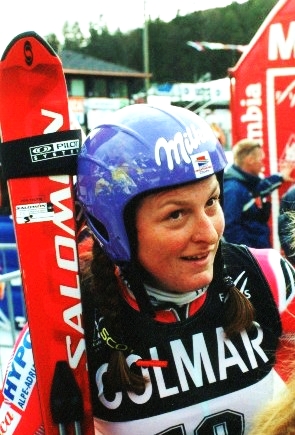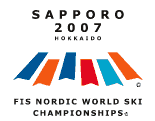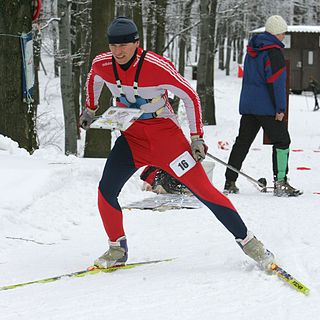This article needs additional citations for verification .(February 2023) |
| 2005 Men's Combined World Cup | |
| Previous: 2004 | Next: 2006 |
Men's combined World Cup 2004/2005
This article needs additional citations for verification .(February 2023) |
| 2005 Men's Combined World Cup | |
| Previous: 2004 | Next: 2006 |
Men's combined World Cup 2004/2005
| Round | Race No | Discipline | Place | Country | Date | Winner | Second | Third |
|---|---|---|---|---|---|---|---|---|
| 1 | 20 | Combined | Wengen | January 14, 2005 | | | |
For the first time the combined was held as a separate event.
In men's combined World Cup 2004/05 only one competition was held. [1]
| Place | Name | Country | Total Points | 20 |
|---|---|---|---|---|
| 1 | Benjamin Raich | 100 | 100 | |
| 2 | Lasse Kjus | 80 | 80 | |
| 3 | Didier Défago | 60 | 60 | |
| 4 | Daniel Albrecht | 50 | 50 | |
| 5 | Kjetil André Aamodt | 45 | 45 | |
| 6 | Pierrick Bourgeat | 40 | 40 | |
| 7 | Christoph Gruber | 36 | 36 | |
| 8 | Peter Fill | 32 | 32 | |
| 9 | Markus Larsson | 29 | 29 | |
| Hermann Maier | 29 | 29 | ||
| 11 | Andrej Jerman | 24 | 24 | |
| 12 | John Kucera | 22 | 22 | |
| 13 | Stefan Thanei | 20 | 20 | |
| 14 | Ambrosi Hoffmann | 18 | 18 | |
| 15 | Mario Scheiber | 16 | 16 | |
| 16 | Scott Macartney | 15 | 15 | |
| 17 | Patrik Järbyn | 14 | 14 | |
| 18 | Alex Antor | 13 | 13 | |
| 19 | Erik Guay | 12 | 12 | |
| 20 | Marco Büchel | 11 | 11 | |
| 21 | Paul Accola | 10 | 10 |
No more finishers in time.
bold indicate highest score - italics indicate race wins
| Place | Country | Total Points | 20 | Racers | Wins |
|---|---|---|---|---|---|
| 1 | 181 | 181 | 4 | 1 | |
| 2 | 138 | 138 | 4 | 0 | |
| 3 | 125 | 125 | 2 | 0 | |
| 4 | 52 | 52 | 2 | 0 | |
| 5 | 43 | 43 | 2 | 0 | |
| 6 | 40 | 40 | 1 | 0 | |
| 7 | 34 | 34 | 2 | 0 | |
| 8 | 24 | 24 | 1 | 0 | |
| 9 | 15 | 15 | 1 | 0 | |
| 10 | 13 | 13 | 1 | 0 | |
| 11 | 11 | 11 | 1 | 0 |

The biathlon is a winter sport that combines cross-country skiing and rifle shooting. It is treated as a race, with contestants skiing through a cross-country trail whose distance is divided into shooting rounds. The shooting rounds are not timed per se, but depending on the competition, missed shots result in extra distance or time being added to the contestant's total.

Nordic combined is a winter sport in which athletes compete in cross-country skiing and ski jumping. The Nordic combined at the Winter Olympics has been held since the first ever Winter Olympics in 1924, while the FIS Nordic Combined World Cup has been held since 1983. Many Nordic combined competitions use the Gundersen method, where placement in the ski jumping segment results in time (dis)advantages added to the contestant's total in the cross-country skiing segment.

The FIS Alpine Ski World Cup is the top international circuit of alpine skiing competitions, launched in 1966 by a group of ski racing friends and experts which included French journalist Serge Lang and the alpine ski team directors from France and the USA. It was soon backed by International Ski Federation president Marc Hodler during the FIS Alpine World Ski Championships 1966 at Portillo, Chile, and became an official FIS event in the spring of 1967 after the FIS Congress at Beirut, Lebanon.

Downhill is a form of alpine skiing competition. Whereas the other alpine skiing events emphasize turning and technique, downhill emphasizes "the six components of technique, courage, speed, risk, physical condition and judgement", according to the FIS "International Ski Competition Rules (ICR)". Speeds of up to 130 km/h (81 mph) are common in international competition. Athletes must have an aerodynamically efficient tuck position to minimize drag and increase speed.

Super giant slalom, or super-G, is a racing discipline of alpine skiing. Along with the faster downhill, it is regarded as a "speed" event, in contrast to the technical events giant slalom and slalom. It debuted as an official World Cup event during the 1983 season and was added to the official schedule of the World Championships in 1987 and the Winter Olympics in 1988.

Janica Kostelić is a Croatian former alpine ski racer. She is a four-time Olympic gold medalist. In addition to the Olympics, she won five gold medals at the World Championships. In World Cup competition, she won thirty individual races, three overall titles, three slalom titles, and four combined titles. Kostelic's accomplishments in professional skiing have led some commentators, writers, and fellow ski racers to regard her as the greatest female ski racer of all time.

The FIS Nordic World Ski Championships is a biennial Nordic skiing event organized by the International Ski Federation (FIS). The World Championships was started in 1925 for men and opened for women's participation in 1954. World Championship events include Nordic skiing's three disciplines: cross-country skiing, ski jumping, and Nordic combined. From 1924 to 1939, the World Championships were held every year, including the Winter Olympics. After World War II, the World Championships were held every four years from 1950 to 1982. Since 1985, the World Championships have been held in odd-numbered years.
Alpine skiing at the 1968 Winter Olympics consisted of six events, held 9–17 February at Chamrousse, southeast of Grenoble, France. Jean-Claude Killy of France won all three men's events, repeating Toni Sailer's triple-gold of 1956. Since Killy's feat, no male alpine ski racer has won three gold medals in a single Olympics..

Alpine skiing has been contested at every Winter Olympics since 1936, when a combined event was held in Garmisch-Partenkirchen, Germany.

Theodore Sharp Ligety is a retired American alpine ski racer, a two-time Olympic gold medalist, and an entrepreneur, having cofounded Shred Optics. Ligety won the combined event at the 2006 Olympics in Turin and the giant slalom race at the 2014 Olympics in Sochi. He is also a five-time World Cup champion in giant slalom. Ligety won the gold medal in the giant slalom at the 2011 World Championships. He successfully defended his world title in giant slalom in 2013 in Schladming, Austria, where he also won an unexpected gold medal in the super-G and a third gold medal in the super combined.
Combined is an event in alpine ski racing. The event format has changed within the last 30 years. A traditional combined competition is a two-day event consisting of one run of downhill and two runs of slalom; each discipline takes place on a separate day. The winner is the skier with the fastest aggregate time. Until the 1990s, a complicated point system was used to determine placings in the combined event. Since then, a modified version, called either a "super combined" or an "Alpine combined", has been run as an aggregate time event consisting of two runs: first, a one-run speed event and then only one run of slalom, with both portions held on the same day.
The 39th World Cup season began in October 2004 in Sölden, Austria, and concluded in March 2005 at the World Cup finals in Lenzerheide, Switzerland. The overall winners were Bode Miller of the U.S. and Anja Pärson of Sweden.
The 20th World Cup season began in August 1985 in Argentina, resumed in December 1985 in Italy, and concluded in March 1986 in Canada. Because of the South America events, this was the first time that the World Cup season had started prior to December 1. The overall champions were Marc Girardelli of Luxembourg, his second consecutive overall win, and Maria Walliser of Switzerland, her first.

The FIS Nordic World Ski Championships 2007 took place 22 February – 4 March 2007 in Sapporo, Japan. It was the second time this city has hosted these championships, having previously done so in the 1972 Winter Olympics. Sapporo was selected as venue by vote at the 43rd FIS World Congress in Portorož, Slovenia, on 6 June 2002. It also marked the third time the championships were hosted outside Europe in a year that did not coincide with the Winter Olympics; it was the first championship held in Asia. The ski jumping team normal hill event was not held, as it had been in 2005.

The FIS Nordic World Ski Championships 2009 took place 18 February – 1 March 2009 in Liberec, Czech Republic. This was the fourth time these championships were hosted either in the Czech Republic or in Czechoslovakia, having done so at Janské Lázně (1925) and Vysoké Tatry.

Ski orienteering (SkiO) is a cross-country skiing endurance winter racing sport and one of the four orienteering disciplines recognized by the IOF. A successful ski orienteer combines high physical endurance, strength and excellent technical skiing skills with the ability to navigate and make the best route choices while skiing at a high speed.
The World Championships of Ski Mountaineering are biannually held ski mountaineering competitions.

The 1994 Winter Olympics were held in and around Lillehammer, Norway, from 12 to 27 February 1994. Ten competition and fourteen non-competition venues were used, most of which were subsequently used for the 1994 Winter Paralympics. The Games were spread out over ten venues in five municipalities in two counties, Oppland and Hedmark. Lillehammer, with approximately 25,000 inhabitants, and Hamar and Gjøvik, both with approximately 27,000 inhabitants, are all situated on the lake Mjøsa. Gjøvik and Hamar are 45 and 54 kilometers south of Lillehammer, respectively. Hunderfossen is 15 kilometers (9.3 mi) north of Lillehammer, but located within the municipality. Øyer and Ringebu, each with just under 5,000 inhabitants, are 18 and 50 kilometers north of Lillehammer, respectively, in the valley Gudbrandsdalen. Lillehammer had four competition venues, Hamar had two competition venues, while Hunderfossen, Gjøvik, Øyer and Ringebu had one competition venue each.

The 47th World Cup season began on 27 October 2012, in Sölden, Austria, and concluded on 17 March 2013, at the World Cup finals in Lenzerheide, Switzerland. The overall titles were won by Marcel Hirscher of Austria and Tina Maze of Slovenia.

The International Ski Federation (FIS) Alpine Ski World Cup, the premier circuit for alpine skiing competition, began in January 1967, and the 2019–20 season marked the 54th consecutive year for the FIS World Cup. As it had every year since 2006, the season began in Sölden, Austria in October. The season was supposed to end with the World Cup finals in March, which were to be held in Cortina d'Ampezzo, Italy for the first time since they began in 1993, but the finals were cancelled due to the COVID-19 outbreak in Italy.